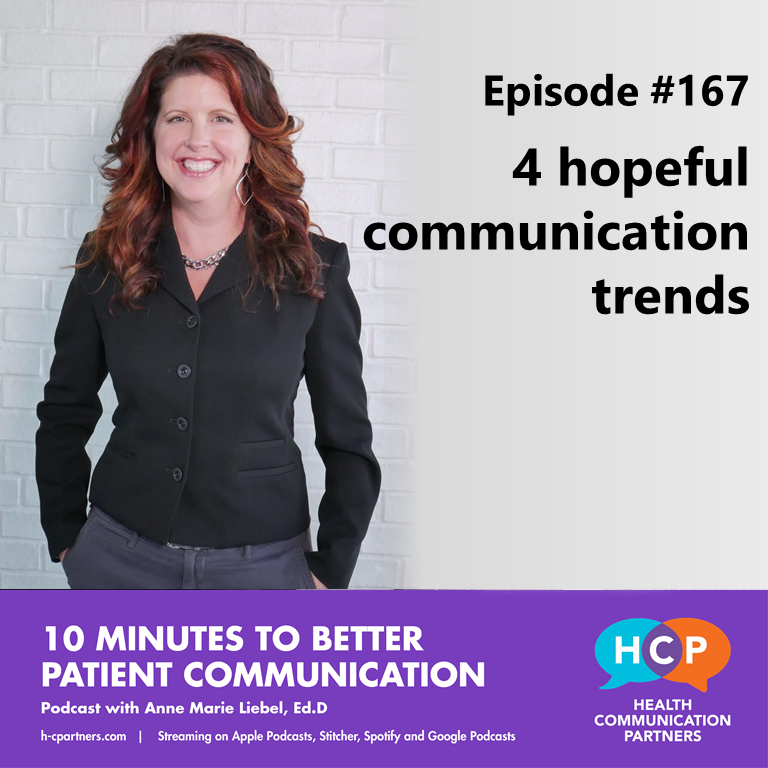Happy New Year! Here are 4 reasons to be hopeful if you care about communication. Got a minute? Tell us what you think of this series (anonymously).

We’re starting 2024 with some good news. Today’s episode is about four trends I’ve been noticing in the communication circles that I run in that I think are reasons to be hopeful.
Hi everybody, this is 10 Minutes to Better Patient Communication from Health Communication Partners. I’m Dr. Anne Marie Liebel. If you like what you’re hearing on this show, you’ll love our courses. Here’s what some learners have said about our course, Equitable Patient Education. “There’s a lot of eye -opening information I hadn’t considered before.” “This course helped me look at myself as an educator and helped me to step back and analyze how I can be a better nurse.” For more information, visit healthcommunicationpartners.com.
Now I love to see what people are doing and fortunately, that’s my job as a consultant and a researcher and a business owner and a podcaster. This communication space we’re all in is big and so are the issues that we work on. They’re also very layered and nuanced. So seeing the pieces of problems that organizations and individuals choose to work on, I find really eye -opening and inspiring. So I want to share with you some of what I’ve been noticing lately in the conversations and projects that I’m a part of that I think is forward -thinking and deserves to be applauded and deserves to be uplifted. Some of the encouraging actions that people are taking and the solutions that they’re seeking.
The status quo has got to go
So first of all, I’ll call it “the status quo has got to go.” This change train keeps rolling and I am happy about that. the momentum to disrupt the status quo in communication is still going. And what I think is really impressive is how many folks are owning up to mistakes, then making commitments to do better, and then acting on those commitments.
For some high profile examples, I’m going to turn to some of our favorite government agencies. First, CMS, John Czajkowski at CMS said, “we can no longer tolerate business as usual. What we need to do is reinvent the way we work.”
From the CDC, we had something similar, specific about communication, in their Moving Forward What It Means for the Future of Health Communication webinar. This webinar, and I’ll go ahead and put links in the notes, was about lessons learned. Evidently, there’s been a lot of reflection and hard conversation going on. at the CDC about what needs to change, and communication was definitely on the table. In the webinar, they said where they wanted to go was to “create communication of care and inclusion that works for all of us and not just some of us.” And I think those are powerful words from the folks who brought us the Health Equity guiding principles for inclusive communication.
They also said one of their goals was to help CDC staff more effectively communicate with the general public. And you know if you’re listening to this show how difficult that task is, to take complicated scientific knowledge and terminology and communicate it to the public– while doing so equitably.
So I applaud this, I support this kind of reflection and action. because that’s what we do here at Health Communication Partners by bringing communication research and perspectives that haven’t yet been widely used across healthcare, but have long track records and are especially well suited to present goals like the ones that we just heard from federal agencies.
Equity and communication
All right, trend number two, equity and communication. People are more broadly aware of some of the many connections between equity and communication. This space is larger than I think people might think which is exciting because that means lots of opportunities. Health Communication Partners exists because years ago, yes pre -COVID, lots of people recognized that paying attention to communication was important to equity. Years ago, people were asking me– then it was about microaggressions and about health literacy, kind of overly discriminatory terms, and all of this is still very necessary.
Rest assured there’s a lot more work to be done in this space. I had, for example, I had a client ask me, “We’re losing people. Our language is way too top -down.” That was a great catch. Another client asked me for help with language that they felt was othering and excluding. I think we all know that language like this contributes to inequitable treatment because so many of the kind of touch points or interactions that people have with health systems and services are done through language.
So lowering barriers to access means getting serious about how we can sometimes get in our own way in communication, doing some soul searching like the CDC was doing. So I am hopeful about this. And I think there’s challenges here. For sure.
First of all, it’s change. It’s tough to imagine alternatives to the way we’ve always done it, because the way we’ve always done it is deeply in our language. Language that keeps people out, or you know holds people back. But I’ve been studying this for years, what equitable communication can mean, what it can look and sound like in different contexts, and that’s what I help clients understand. So I know we can do this, lower the barriers to access by looking closely at the communication that we’re already doing. Yay on the trend of equity and communication together.
Collaboration and communication
Another communication trend I’m seeing is the continued emphasis on collaboration. Now, if we’re gonna sustain this change, I think a lot of people realize we need support in doing that. So it doesn’t become kind of silo’ed. It doesn’t become the responsibility of just kind of those people over there.
How do we sustain the change? How do we sustain ourselves? ourselves? And one way I’m seeing organizations answering this question is collaboration. Again, back to CMS on this, one of the speakers at this recent event that I was at said, “When we dare to disrupt systems, we need to learn from one another and share information and do everything we can to build the best relationships we can have.”
Another example I wanted to tell you about is from a MedEd conference I was at Anti-Racist Training in MedEd. Recently I was presenting about our Equitable Communication Course. And a few comments from participants at that at the conference are also about just the real crucial nature of collaborations. because as one person put it, “A lot of us work in very silo’ed spaces where you only talk about your work with maybe a few people. You don’t realize down the hall someone else can inform what you’re doing. Community and connection is something that can break down those barriers.”
And this was echoed by another participant saying, “Connection mitigates trauma. Bringing people together to talk about the emotions of this work can be helpful.” I was also talking with a client who’s in cancer research who really pointed out how important it is for that organization to have increased representation of underrepresented groups in decision -making positions in the healthcare setting and other institutions.
So again, I’m applauding this recognition of how important it is to have people around the table communicating, collaborating. Are there challenges here? Absolutely. One of them is that communication champions like yourselves at all levels are spread thin. and collaboration is complicated. We can’t just put people in the same space and call it a collaboration. I’m gonna put a link in the show notes to our episode with our friend, Sam Cinnick from HRSA, talking about just this very topic.
Because we help in this area, whether you’re looking at collaboration for support, addressing common problems and barriers, or you really wanna get to work developing more equitable solutions, contact me. You know how to do that.
Workplace communication
All right, fourth trend that I’m super happy is still going strong with communication has to do with communication at work, interprofessional communication. At that MedEd conference that I mentioned, I saw a presentation by Sarita Martínez at Columbia University with her colleagues, Keshia Pershad and Todd Bates. They described their work as “concerned with the promotion, retention, reward, and recognition of the exceptional staff that our institution attracts but does not always successfully retain, celebrate, or protect.” Now that’s a space I am in as well, so I was very excited for their talk. It was about using the Surgeon General’s framework for workplace mental health and well -being. And more or less they were saying, you know, in a lot of workplaces, but specifically in theirs, “there’s a baseline of respect you can expect from your colleagues and that they can expect from you, but some people are just not experiencing that.”
And I think we’ve all heard some of these statistics. They were emphasizing how important it is to recognize that reality and hold leadership accountable for what they can do to create a safe space. And this is where communication came in. At its most basic level, this is about how people address one another and talk to each other and how we interact with each other. This is communication in the workplace. And what I’m being asked to do most as a consultant is this continuous quality improvement on communication, including interprofessional communication at the workplace.
So those are our four trends that I want to applaud. and I’m hopeful because across them I’m seeing a real rethinking and an openness to different ways of framing and enacting communication. There’s so much sophistication. There’s a lot of maturation here. And when we’ve got large organizations and agencies saying publicly, we can do better, we must do better, I want to applaud that and support it. Because this is a long road, folks, but we are on it together. This has been 10 Minutes to Better Patient Communication from Health Communication Partners. Audio engineering and music by Joe Liebel. Additional music by Alexis Rounds.

